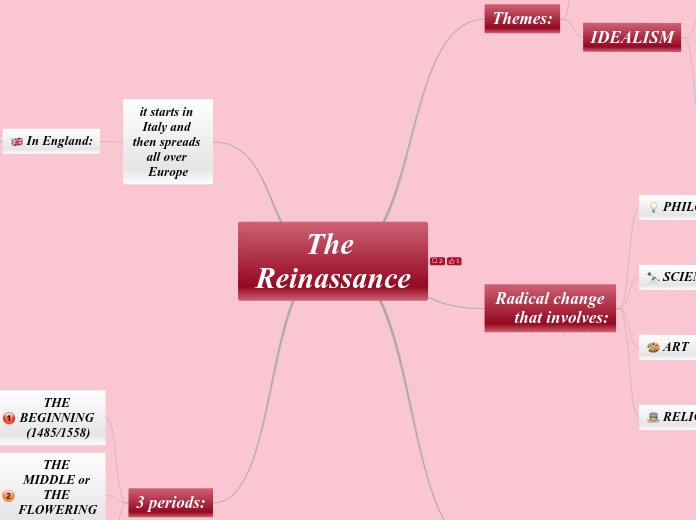The Reinassance
Themes:
INDIVIDUALISM
IDEALISM
1st part: characterized by Thomas More
He writes ''Utopia''
means ''nowhere'' (is an imaginary world)
everything is perfect and in harmony
one of the most important English Humaniist
2nd part: humankind turns back to reality
Radical change that involves:
PHILOSOPHY
The philosopher introduces a new scientific philosophy
SCIENCE
We have a shift from Ptolemaic to Heliocentric system
ART
Artists get inspiration from the past (Classicism)
RELIGION
There is a gradual passage to the Reformation
DRAMA
it takes inspiration to
Medioeval genres
like INTERLUDES
it is a short entertainment used as an interval. It relieves tension between acts.
Classical models (Greek and Latin works)
like MASQUE
characterized by music, dance and drama
it starts in Italy and then spreads all over Europe
In England:
The raise of the Tudors Dynasty
it starts with HENRY VII
he adopts a marriage policy
HENRY VIII (his son)
separates the Church of England from the Church of Rome. He became the head of the Church of England (Act of Supremacy)
EDWARD VIII (Henry VIII's son)
MARY TUDOR (Henry VIII's daughter) became queen. She wants to restore Catholicism.
ELIZABETH I reestablished the anglican religion with the act of supremacy
JAMES I STUART started the STUARTS' DYNASTY
The printing Press
introduced by William Cexton
3 periods:
THE BEGINNING (1485/1558)
THE MIDDLE or THE FLOWERING (1558/1603)
Also called: ''the Elizabethan Era''
THE DECLINE (1603/1625)
Also called: ''the Jacobean Age''
Also known as ''the Age of Shakespeare''
Represents the Golden Age of LITERATURE
this variety of popular and refined cultures makes drama appealing to everybody (poor and rich people)
TRAGEDY
follows a pattern of 5 acts
introduction
development
crisis
decline
achieves CATHARSIS:is the purification of emotion. It's a kind of empathy.
final outcome/catastrophe/death of the HERO
THE HERO/THE HEROINE: -is a king or a nobleman who has power and honour -he/she commits a final mistake -accepts consequences of his/her actions -this condition makes him fall
is an imitation of a serious action without narration (people act directly)
ELIZABETHAN TRAGEDY:
follows conventional
acting
structure
places
costumes
features
revenge
bloody
ghosts
tragic elements
